Understanding Chapter 1 of the Maharashtra Regional Town Planning Act 1966: A Comprehensive Overview; Here is the detailed description of Chapter 1 of The Maharashtra Regional Town Planning Act 1966 (MRTP ACT 1966), with Definitions and relevant Case Laws.
Also Read: MRTP ACT 1966-THE MAHARASHTRA REGIONAL TOWN PLANNING ACT 1966: CONTROLLING URBAN SPRAWL- PART 1
PRELIMINARY
Section 2-
Definitions:
In this Act, unless the context otherwise requires,
1. “Agriculture”

The definition of “agriculture” under the Maharashtra Regional and Town Planning Act, 1966 is provided in section 2(1) of the Act. According to this section, “agriculture” includes a wide range of activities related to farming and cultivation.However, the definition of “agriculture” does not include the use of land as a garden which is an appendage to a building. The term “agricultural” shall be construed accordingly, which means that any activity related to agriculture as defined under this section shall be treated as an agricultural activity, while anything which falls outside this definition shall not be considered agricultural. The purpose of this definition is to provide clarity and avoid confusion in cases where the use of land is in question, especially with regard to the acquisition of agricultural land for non-agricultural purposes.
2. “Amenity”

Amendment-
The issue of illegal and unauthorized construction by developers/builders is a contentious one, particularly in the context of town planning. In the case of Esha Ekta Apartments Co-operative Housing Society Ltd. and Others v. Municipal Corporation of Mumbai and Others, it was held that flat buyers who have purchased units in buildings that have been illegally and/or unauthorizedly constructed by developers/builders cannot seek a direction for the regularization of such construction.
Instead, the only remedy available to such flat buyers is to sue the lessee and the developer/builder for the return of the money paid and/or for damages incurred. This means that the flat buyers are entitled to seek compensation from the developer/builder for any loss or damage suffered as a result of the illegal or unauthorized construction.
The Court clarified that regularizing such construction would be against the principles of town planning and would set a bad precedent. It would not only encourage builders/developers to flout the law but also undermine the role of the local authority in enforcing the town planning regulations.
In the absence of any provision under the Maharashtra Regional and Town Planning Act, 1966, or any other relevant law, the Court held that the local authority could not be directed to regularize unauthorized or illegal construction. It was the responsibility of the developer/builder to ensure that any construction carried out was in accordance with the applicable town planning regulations.
The Court observed that the local authority had a duty to ensure that the town planning regulations were complied with, and any deviation from such regulations would be viewed seriously. Therefore, the Court refused to grant any relief to the flat buyers seeking regularization of the illegal and unauthorized construction.
In conclusion, the decision in the Esha Ekta Apartments Co-operative Housing Society Ltd. case highlights the importance of compliance with town planning regulations. It also emphasizes the need for developers/builders to ensure that any construction carried out is in accordance with such regulations. Flat buyers who have been affected by illegal or unauthorized construction can seek compensation from the developer/builder, but they cannot seek a direction for regularization of such construction.
Also Read: https://legalreferencer.in/environmental-laws-in-india-upsc-a-upsc-primer/
3. “Appropriate Authority”

The term “Appropriate Authority” refers to the public authorities designated with powers under the provisions of the act during the implementation of the Development Plan. Essentially, it pertains to any public authority that designates land for public purposes. In Maharashtra, the State Government is also recognized as an Appropriate Authority.
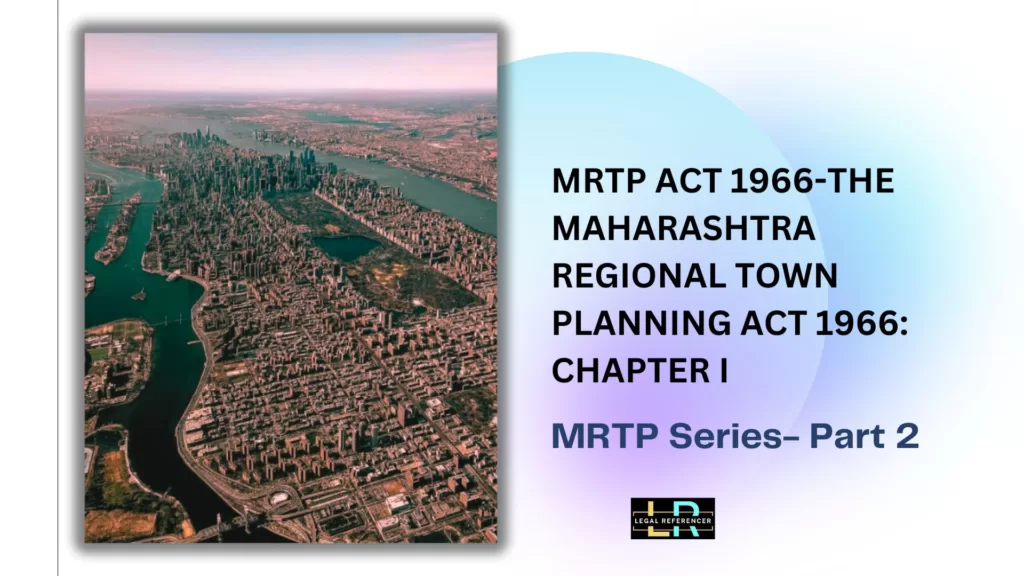
4. “Arbitrator”

Section 72 provides for the resolution of disputes and differences that may arise in the implementation of any scheme or provision of the Act. The disputes may be between the planning authority and any person, or between two or more persons who have a claim or interest in any land or property that is affected by the scheme.
The appointment of an Arbitrator is essential to resolve such disputes, and the person appointed should have expertise in the relevant field. The Arbitrator is responsible for making a fair and impartial decision on the dispute, and his decision is binding on the parties involved. The Act provides for the appointment of one or more Arbitrators, and the decision of the Arbitrator is final and binding on all parties. The Arbitrator should have the necessary qualifications, experience, and knowledge to deal with the dispute effectively and efficiently.
5. “Building operations”

This excerpt is a definition of “building operations,” which refers to a variety of construction activities that involve the erection, alteration, or enlargement of a building. Specifically, the following activities are included:
Erection or re-erection of a building or any part thereof: This refers to the construction of a new building or the reconstruction of an existing one.
Roofing or re-roofing of any part of a building or of any open space: This refers to the installation of a new roof or the replacement of an existing one on a building or any open space.
Any material alteration or enlargement of a building: This refers to any significant change or addition made to a building that alters its structure, function, or appearance.
Any such alteration of a building as is likely to affect an alteration of its drainage or sanitary arrangement or materially affect its security: This refers to any alteration that affects the building’s drainage or sanitary systems or its overall security.
The construction of a door opening on any street, or land not belonging to the owner: This refers to the creation of a new door or entrance on a building that opens onto a street or land that is not owned by the building’s owner.
In summary, “building operations” encompasses a range of construction activities related to the erection, alteration, and enlargement of a building, as well as the installation of new roofs and doors.
(5A) “Compounded structure”

The term “compounded structure” refers to a development of land that has been granted legal permission by the relevant authorities upon the payment of certain charges and premiums.
In India, under the provisions of sub-section (2B) of section 18 or section 52A, the Collector or Planning Authority has the power to levy charges and premiums on any development of land, which includes the construction of a building or any other structure. These charges may be for compounding, which means regularising an unauthorised or illegal development of land, or for infrastructure such as water, electricity, or sewage connections.
Once the owner or occupier of the structure pays these charges and premiums, the Collector or Planning Authority will declare the structure as a “compounded structure.” This declaration is a legal recognition that the structure is authorised and compliant with the relevant laws and regulations.
The Maharashtra Town Planning (Compounded Structures), Rules of 2017 are applicable to all types of structures except those in eco-sensitive areas and buffer zones. These rules were proposed by the Maharashtra government through the exercise of powers conferred under subsection (1) of Section 52A and clause (xxxviii) of subsection (2) of Section 158 of the Maharashtra Regional and Town Planning Act, 1966. These rules provide a framework for regularization of structures that have been constructed without obtaining requisite permissions. The Maharashtra Town Planning (Compounded Structures), Rules of 2017 were drafted with the aim of bringing about a balance between the need for regularization of such structures and the need to prevent further unauthorized construction. The rules outline the procedures and conditions for regularization and provide a mechanism for imposing penalties on those who violate them.
6. “Court”

means in Greater Bombay, the Bombay City Civil Court; and elsewhere, the principal Civil Court of original jurisdiction; and includes any other Civil Court of a Judge of Senior Division or a Judicial Officer empowered by the State Government to perform the functions of the Court under this Act within the pecuniary and local limits of its jurisdiction;
(6A) “Designated Officer”
means the officer designated under subsection (8) of section 53”.
7. “Development”

The term “development” and its grammatical variations are defined as follows:
The carrying out of buildings, engineering, mining or other operations in, over, or under land: This refers to the construction of buildings, roads, bridges, tunnels, or any other structures, as well as any operations related to mining or excavating land.
The making of any material change in any building or land or in the use of any building or land: This refers to any alteration or modification made to an existing building or land, or a change in its use or purpose.
Any material or structural change in any heritage building or its precinct: This refers to any change made to a heritage building or its surrounding area that alters its character or historical significance.
Demolition of any existing building, structure or erection, or part of such building, structure or erection: This refers to the dismantling or destruction of any existing building or part of it, including any structures or erections that are attached to it.
Reclamation, redevelopment and lay-out, and sub-division of any land: This refers to the process of converting a piece of land into a usable or developed space by reclaiming it from the sea, developing it with buildings or infrastructure, subdividing it into smaller plots, or redeveloping existing buildings or areas.
The term “to develop” is used to describe the action of carrying out any of the above activities related to land and property development.
In summary, “development” in the context of land and property refers to any construction, alteration, modification, demolition, or other operations carried out on land or buildings, as well as the reclamation, redevelopment, and sub-division of land.
The term “Development Right” refers to the right to carry out development on a piece of land or building. It encompasses the transferable development right that allows the utilization of the floor space index of land that is either partially reserved for public purpose or located elsewhere, as specified in the development control and promotion regulations. In simpler terms, it is a legal right granted to landowners or lessees to develop their land or property for commercial or residential purposes within the limits prescribed by the regulations. This right can be transferred to another person or entity, who can then use it for their own development purposes. The concept of transferable development rights allows landowners to surrender a portion of their land to the government for public use and receive development rights as compensation, which can then be sold or utilized for their own development projects.
8. “Development Authority”
means a New Town Development Authority 1[constituted or declared under section 113-
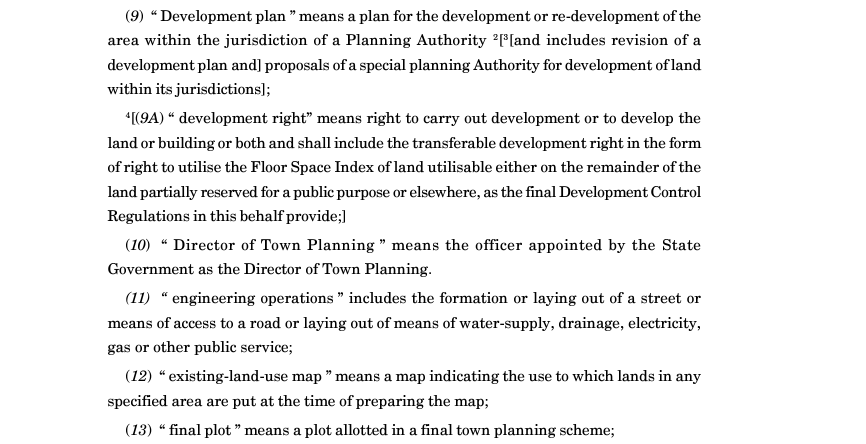
9. “Development plan”
Development and building operations are closely related terms. To ensure the effective implementation of a development scheme, it is essential to prioritize the interests of society and civic amenities over those of individuals. This implies that the individual’s interests cannot override the broader social interest. For instance, if the development scheme requires the acquisition of an individual’s land, then the local authorities have the power to compulsorily acquire it to ensure that the development scheme is not negatively impacted/
The term “development plan” refers to a comprehensive plan that outlines the proposed development or redevelopment of an area within the jurisdiction of a Planning Authority. The plan serves as a blueprint for the future development of the area and takes into account various factors such as population growth, infrastructure requirements, and environmental concerns.
Effective implementation of a development plan requires prioritizing the interests of society and civic amenities over those of individuals. This means that the interests of the community and public welfare are paramount and take precedence over the interests of individuals.
For instance, in some cases, the development plan may require the acquisition of an individual’s land. In such cases, the local authorities have the power to compulsorily acquire the land to ensure that the development scheme is not negatively impacted. This is done to ensure that the interests of society as a whole are prioritized over the interests of a few individuals.
In summary, the development plan is a comprehensive plan that outlines the proposed development or redevelopment of an area within the jurisdiction of a Planning Authority. To ensure effective implementation, the interests of society and civic amenities must take priority over the interests of individuals, and local authorities have the power to compulsorily acquire land to ensure that the development plan is not negatively impacted.
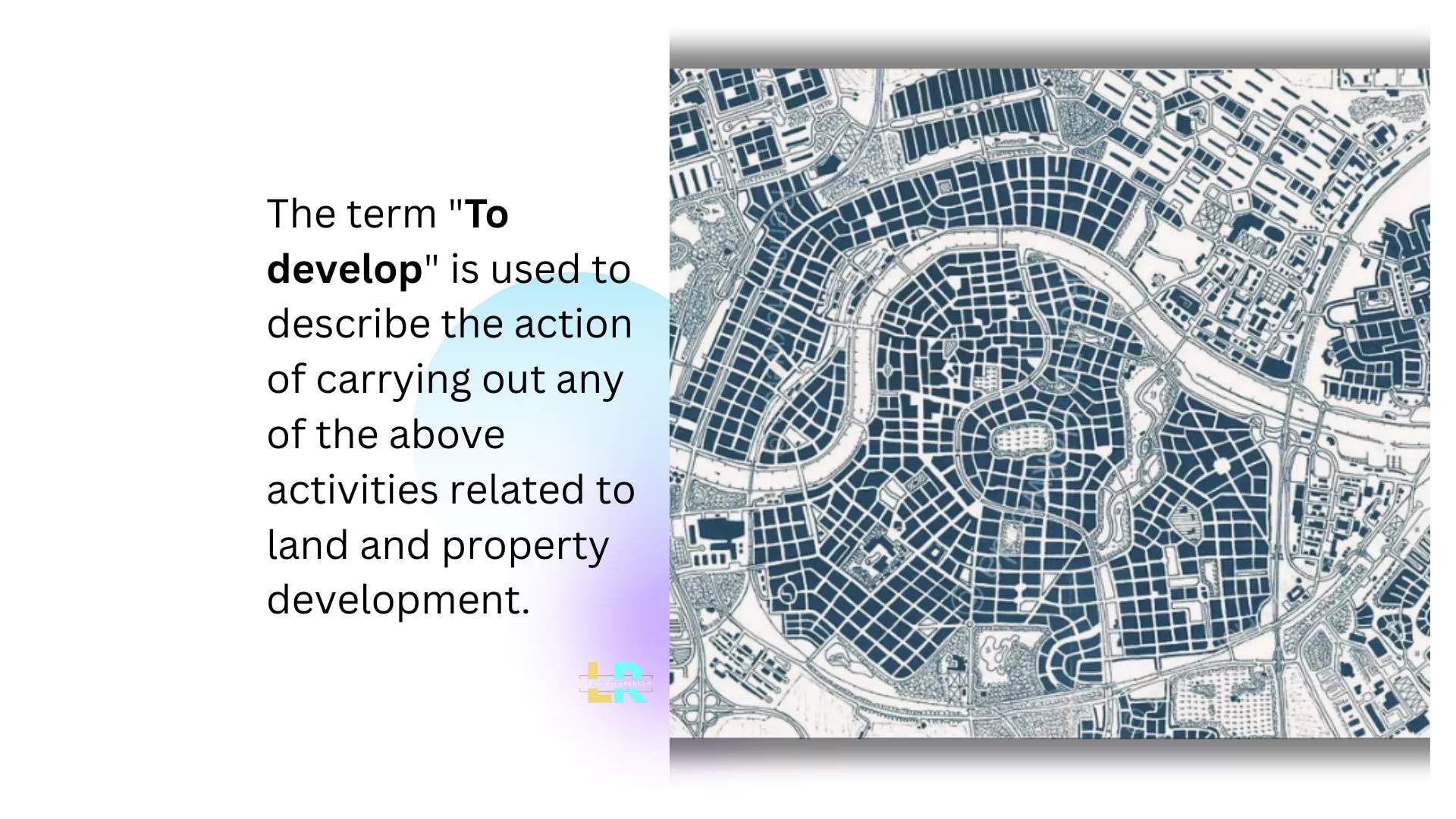
(9A) “Development right”
In simple terms, Transferable Development Rights (TDR) can be utilized by a landowner or developer in the manner and to the extent allowed by the Development Control Regulations. These regulations provide guidelines for the utilization of TDR in the form of additional construction rights or floor space index. The case of Fairview Cooperative Housing Society Ltd. v. Savinder S. Rekhi and Others in 2008 upheld the principle that TDR can only be used within the parameters set by the Development Control Regulations. The regulations ensure that TDR is not misused or exploited, but instead used to enhance the development of the region in a sustainable and controlled manner. This helps to ensure that the benefits of TDR are maximized for the community as a whole while minimizing any negative impacts on the environment or the community.
10. “Director of Town Planning”
means the officer appointed by the State Government as the Director of Town Planning;
11. “Engineering operations”
includes the formation or laying out of a street or means of access to a road or laying out of means of water supply, drainage, electricity, gas or other public service;
12. “Existing-land-use map”
means a map indicating the use to which lands in any specified area are put at the time of preparing the map;
13. “Final plot”
means a plot allotted in a final town planning scheme;
(13A) “Floor Space Index”
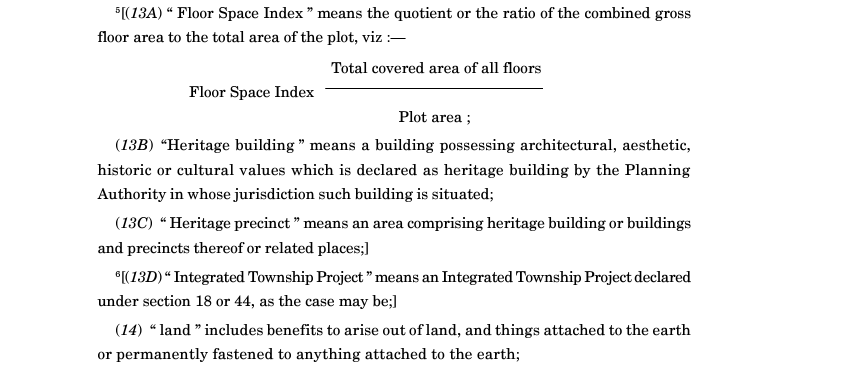
Floor Space Index (FSI) is a crucial concept in urban planning and real estate development. It refers to the ratio of the total floor area of a building to the size of the land it is built on. In Mumbai, the competent authority sets a basic FSI that is allowed as a matter of right without any additional cost. This means that developers are permitted to build up to a certain floor area without having to pay any extra fees to the government.
However, if a developer wants to build beyond the basic FSI, they can do so by paying an additional charge to the competent authority. This is known as chargeable or premium FSI. The maximum permissible FSI includes both the basic FSI and any additional FSI that is chargeable.
Mumbai is a city with a very high demand for floor space due to its large population and booming economy. However, the city is limited in its ability to expand horizontally due to its linear geography and land constraints. This means that developers have to build vertically, which puts even more pressure on the available land and resources. As a result, the concept of FSI plays a critical role in determining the built-up area of a property and its value.
In urban planning and real estate development, the Floor Space Index (FSI) is a critical concept that refers to the ratio of the total floor area of a building to the size of the land it is built on. The Basic FSI is the maximum FSI allowed on any parcel of land without any extra charges or premiums. This means that a developer can build up to a certain floor area without having to pay any additional fees to the government or other authorities.
The Basic FSI is determined by the competent authority, which sets the rules and regulations for building construction in a given area. These regulations specify the maximum FSI allowed on a particular parcel of land without any additional charges. Therefore, the Basic FSI is the permissible FSI without any levy of premium or loading of TDR (Transferable Development Rights) on the land.
In summary, the Basic FSI is the maximum FSI allowed on a parcel of land without any additional charges or premiums, as per the provisions of the regulations set by the competent authority.
(13B) “Heritage building”
A heritage building is a building that possesses significant architectural, aesthetic, historic, or cultural value, and has been officially recognized and protected by the Planning Authority, Heritage Conservation Committee, or any other competent authority in whose jurisdiction the building is located. These buildings are usually considered to be important landmarks and symbols of a city’s cultural heritage and are preserved for future generations.
The significance of a heritage building lies in its historical and artistic value. Such buildings may have been constructed many decades or even centuries ago and may represent a particular era or architectural style. They may also have played a significant role in the history of a place or have been associated with a famous person or event. Heritage buildings are also significant from an aesthetic point of view, as they may feature intricate designs, beautiful decorations, and unique architectural elements.
To protect heritage buildings from being altered or destroyed, various laws and regulations have been put in place by the competent authorities. These regulations often restrict any changes to the original structure, design, or facade of the building. In some cases, the authorities may even provide financial assistance to the owners of heritage buildings for the purpose of restoration and preservation.
(13C) “Heritage precinct”
A heritage precinct refers to an area that includes one or more heritage buildings, along with their surrounding precincts or related places that share a common physical, social, or cultural significance worth preserving and conserving. The concept of a heritage precinct is closely related to that of a heritage building, but it expands beyond individual buildings to encompass the entire area that has historical, cultural, or social significance.
A heritage precinct may include not only the heritage buildings themselves, but also the surrounding landscape, streetscape, and public spaces that contribute to the overall cultural value of the area. The buildings and other structures within a heritage precinct are often of architectural, historical, cultural, or social significance and contribute to the sense of place and identity of a community.
The preservation and conservation of a heritage precinct is important as it ensures the continuity of cultural traditions, historical events, and architectural styles. It also contributes to the economic, social, and cultural development of a community, by attracting visitors and tourists who are interested in the heritage and cultural significance of the area.
In summary, a heritage precinct is an area comprising heritage buildings or structures and their surrounding precincts or related places that share a common physical, social, or cultural significance worth preserving and conserving. The preservation and conservation of heritage precincts are crucial to maintain the cultural identity and heritage of a community and to promote economic, social, and cultural development.
(13D) “Integrated Township Project”
An Integrated Township Project (ITP) is a real estate development project that aims to provide a self-contained and sustainable living environment to its residents. ITPs are designed to have all the necessary facilities and amenities within the township itself, such as housing, healthcare, education, shopping, entertainment, and recreational spaces. The concept of ITPs was initially introduced in India as Special Township Projects (STPs) in 2004 by the Maharashtra government.
The Maharashtra Village Panchayat and Maharashtra Regional Town Planning Amendment Act, 2014, Maharashtra Act 43 of 2014, amended the previous regulations and replaced the STP with ITP. This amendment was made to ensure that the development of large-scale integrated townships was carried out in a more organized and regulated manner. The new regulations provided a framework for the development of ITPs, which included guidelines for planning, construction, and management of these townships.
ITPs are typically developed on a large area of land, ranging from 100 acres to thousands of acres, and are planned as self-sustaining communities with all the necessary infrastructure and amenities. These townships are usually located on the outskirts of cities or in rural areas, where land is available for large-scale development. The objective of ITPs is to provide a better quality of life for residents by providing a complete and self-sufficient living environment.
In summary, ITPs are large-scale real estate development projects designed to provide a self-contained and sustainable living environment to residents. The concept of ITPs was introduced in India as STPs in 2004, which was later replaced by ITPs in 2014 by the Maharashtra government through an amendment to the Maharashtra Village Panchayat and Maharashtra Regional Town Planning Act. The new regulations provided a framework for the planned development of ITPs to ensure that these townships are built in an organized and regulated manner.
14. “Land”
Land refers to a portion or solid part of the surface of the earth that is not covered by a body of water. It is a type of immovable property that is owned by someone. The term “Land” includes everything annexed to it, whether by nature or human hand. This means that it encompasses not only the soil and natural resources of the land, but also any buildings, structures, or improvements that are permanently attached to it.
The concept of land ownership is important in real estate, as the legal rights to the land and its attached improvements determine ownership and usage rights. Land can be owned privately or publicly, and the ownership rights can be transferred through sale, inheritance, or other legal means.
The definition of land also includes any benefits that arise out of the land or things attached to it. For example, if a landowner has mineral rights or timber rights, these are considered part of the land and are included in the definition of land ownership. Similarly, any buildings or structures that are attached to the land, such as houses, barns, or factories, are also considered part of the land.
Land can be used for a variety of purposes, including agriculture, residential, commercial, industrial, and recreational purposes. The ownership and usage rights of the land determine how it can be used and developed. In urban areas, land is often zoned for specific purposes, such as residential, commercial, or industrial use, and landowners must comply with local zoning regulations when developing their land.
In summary, land is a portion or solid part of the surface of the earth that is not covered by water and is considered immovable property. The definition of land includes everything annexed to it, whether by nature or human hand, and encompasses any benefits that arise out of the land or things attached to it. The usage and development of land are governed by legal ownership and zoning regulations.
15. “Local authority”
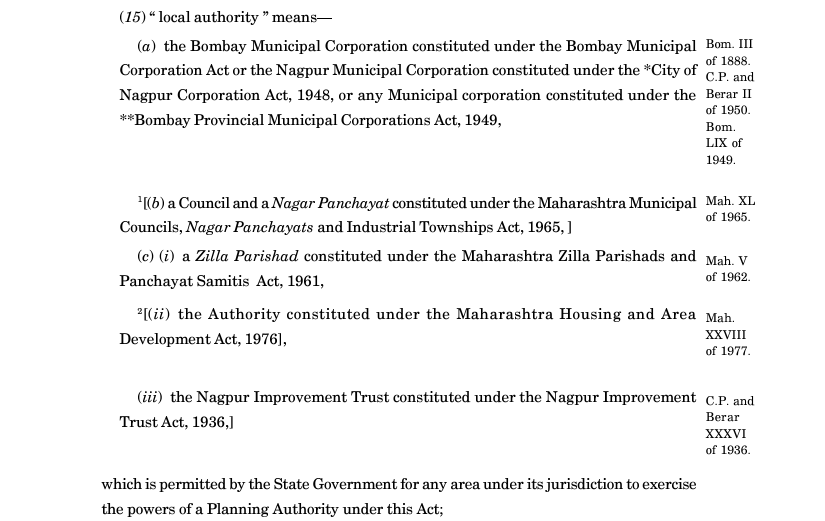
In India, the State Government authorizes certain Municipal Corporations to exercise the power of planning authority for any area under their jurisdiction. These planning authorities are responsible for regulating land use, granting development permissions, and ensuring that the development in their respective areas is in line with the applicable laws, regulations, and policies.
No person is authorized to change the use of land or building or carry out development without prior permission from the planning authority. This is applicable to all lands covered under the scheme and when the development plan is published for a particular region in the official gazette. This means that any change in land use, construction of new buildings, or alterations to existing structures must be approved by the planning authority before any work can commence.
The planning authority has the power to grant or refuse permission for development based on various factors such as zoning regulations, building codes, environmental impact, and public safety concerns. They may also impose conditions on the development, such as requirements for green spaces, parking facilities, or other amenities.
The Municipal Corporations authorized by the State Government to act as planning authorities vary from state to state. In some cases, the planning authority may be a separate entity, such as a development authority or a regional planning board. Regardless of the specific organizational structure, the planning authority is responsible for ensuring that development in their respective areas is sustainable, equitable, and in line with the overall vision and goals of the local government.
In summary, the State Government authorizes certain Municipal Corporations to exercise the power of planning authority for any area under their jurisdiction. These planning authorities are responsible for regulating land use and granting development permissions, and no person is authorized to change the use of land or building or carry out development without their prior permission.
16. “Local newspaper”
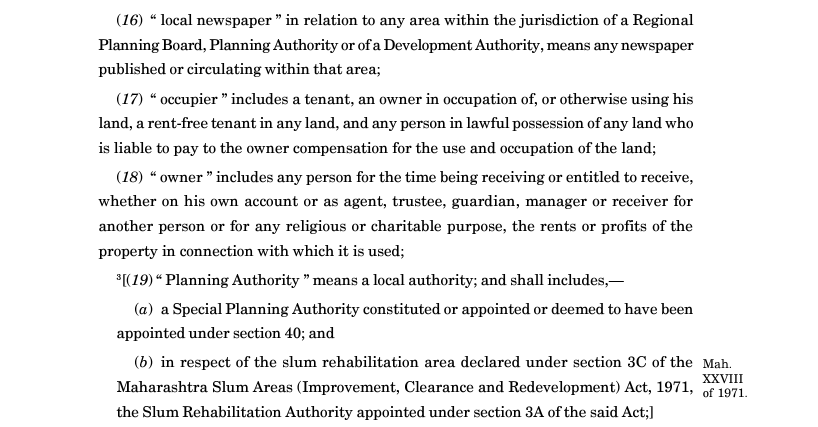
In the context of Regional Planning Boards, Planning Authorities or Development Authorities in India, a local newspaper refers to a newspaper that is published within the area or jurisdiction of the respective authority. The purpose of a local newspaper is to provide information and updates about the developments, projects, and initiatives undertaken by the planning authority in that particular region.
The local newspaper can be published in any language spoken in the region, depending on the linguistic diversity of the area. It may cover news related to urban planning, development projects, infrastructure initiatives, public services, and other relevant topics that affect the local population.
Local newspapers are an important means of communication between the planning authority and the local residents. They serve as a platform for the authority to inform the public about its plans and initiatives, and also for the residents to voice their opinions and concerns. Local newspapers also provide an opportunity for the planning authority to solicit feedback from the public on various issues related to urban planning and development.
The requirement for local newspapers is often stipulated in the regulations or guidelines issued by the planning authority. The authority may require developers or other stakeholders to publish advertisements related to their projects or initiatives in the local newspaper, in order to inform the public and solicit feedback. This requirement ensures that the local population is aware of the various development projects and initiatives taking place in their area and can participate in the decision-making process.
In summary, local newspapers are those that are published within the area or jurisdiction of the Regional Planning Board, Planning Authority or Development Authority. They serve as an important means of communication between the planning authority and the local population and help to ensure transparency and public participation in the urban planning and development process.
17. “Occupier”
In the context of land and property ownership, an “Occupier” is a person who is lawfully in possession of a land or property. This means that the occupier has acquired the right to possess the property through legal means such as lease or ownership.
A person who has taken possession of a land or building without any legal right or authorization cannot be considered an occupier. Such a person is referred to as a “trespasser” and can be evicted by the owner of the property or by the appropriate legal authorities.
The legal rights of an occupier are determined by the terms of the lease agreement or the ownership rights of the property. For instance, if a person has leased a property, they have the right to occupy the property for the duration of the lease term, subject to the terms and conditions of the lease agreement. On the other hand, if a person owns the property, they have the right to occupy it for as long as they wish, subject to any applicable laws and regulations.
The rights and responsibilities of an occupier may vary depending on the nature and location of the property. For instance, an occupier of a commercial property may have additional responsibilities such as ensuring compliance with safety regulations and maintenance of the property. In some cases, the occupier may also have the right to sub-let the property or make modifications to it, subject to the terms of the lease agreement.
In summary, an occupier is a person who is lawfully in possession of a land or property. The legal rights of an occupier are determined by the terms of the lease agreement or the ownership rights of the property. A person who has taken possession of a property without any legal authorization cannot be considered an occupier.

18. “Owner”
The term “owner” has a wide connotation and extends beyond just the legal owner of the property. According to the definition in various laws and regulations, an “owner” includes any person who is receiving or entitled to receive the rent or profits of the property, whether on his own account or as an agent, trustee, guardian, manager or receiver for another person or for any religious or charitable purpose.
Thus, an “owner” can be an individual, a group of individuals, a company, a trust, or any other entity that has a right to receive the rent or profits from a property. It is not necessary for the owner to have legal title to the property, as long as they are receiving the rent or profits from it.
This definition is important in various legal and regulatory contexts, as it allows for a more comprehensive understanding of the ownership of a property and the rights and responsibilities associated with it. For example, in the context of property taxation, the owner of a property is responsible for paying property taxes, regardless of whether they have legal title to the property or not. Similarly, in the context of building regulations, the owner of a building is responsible for ensuring that the building is constructed and maintained in compliance with the relevant regulations, even if they have appointed a manager or agent to handle these tasks.
19. “Planning Authority”
Section 40 of the Maharashtra Regional and Town Planning Act, 1966 provides for the constitution of an authority by the State Government for any undeveloped area. This authority is known as the Special Planning Authority (SPA) and is constituted for the purpose of undertaking the preparation and implementation of a development plan for the notified area.
The SPA is composed of several members, including a Chairman, Vice-Chairman, a member of the Maharashtra Legislative Assembly representing the notified area, one member representing the Municipal area, the Deputy Director of Town Planning, executive Engineer, Public Health Works Division, each having jurisdiction over the notified area and an officer not below the rank of an Assistant collector. The Chairman of the SPA is generally an officer of the Town Planning and Valuation Department.
The primary responsibility of the SPA is to prepare and implement the development plan for the notified area. This includes the acquisition of land, development of infrastructure, and the regulation of land use. The SPA is also empowered to undertake other related activities, such as the preparation of a land use survey and the preparation of a town planning scheme.
The SPA is an important authority in the implementation of town planning schemes and the development of urban areas in Maharashtra. It plays a vital role in ensuring that the development of urban areas is carried out in a planned and sustainable manner, with a focus on the provision of basic infrastructure and amenities to the residents of the area.
20. “Prescribed”
means prescribed by rules made under this Act
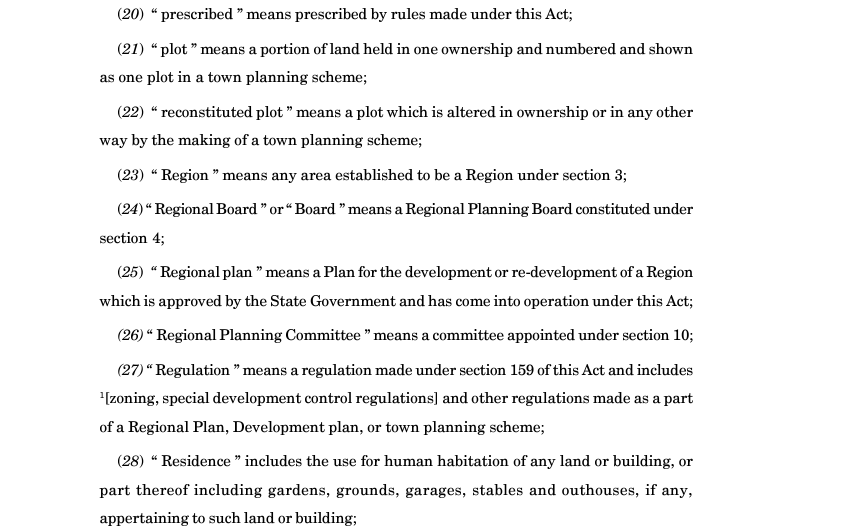
21. “Plot”
means a portion of land held in one ownership and numbered and shown as one plot in a town planning scheme-
In the context of town planning, the term “plot” refers to a specific portion of land that is held in one ownership and is designated as one unit within a town planning scheme. A town planning scheme is a legal document that outlines how land within a particular area is to be developed and used.
A plot is typically identified by a specific number or designation within the town planning scheme, and is shown as a single unit on a map or plan of the area. A plot can be of various sizes and shapes, depending on the specific town planning scheme and the purpose for which the land is intended.
The designation of a plot within a town planning scheme serves several purposes. It allows for the orderly and planned development of an area, as well as the effective allocation of infrastructure and services such as roads, water supply, and sewage systems. It also enables local authorities to enforce regulations and zoning laws, and to ensure that the development of land within the area is consistent with the overall goals and objectives of the town planning scheme.
In summary, a plot is a designated portion of land that is held in one ownership and is identified as a single unit within a town planning scheme. The designation of a plot within a town planning scheme is important for ensuring the orderly and planned development of an area, as well as the effective allocation of infrastructure and services.
22. “Reconstituted plot”
In the context of urban planning, a reconstituted plot refers to an additional area of land that is created through the process of land readjustment or land pooling. This typically happens when the government or a planning authority acquires land from different landowners for a specific development project, such as building a new road, park, or residential complex.
The planning authority can then reconstitute the acquired land parcels into larger, more cohesive plots that are better suited for development. The reconstituted plots are typically redistributed to the original landowners in proportion to the size of their original holdings. This process can help to streamline the development process, as it can reduce the number of landowners involved in a particular project and provide larger, more contiguous areas of land for development.
In the context of the Maharashtra Regional and Town Planning Act, 1966, the reconstituted plot is an additional area that is included in the draft development plan prepared by the planning authority for a particular jurisdiction. This additional area may be included in the plan for various reasons, such as to accommodate future growth or to correct any irregularities or inefficiencies in the existing land use pattern. The reconstituted plot is a tool that can be used by the planning authority to ensure that land is used in the most effective and efficient way possible, in order to support the long-term development and growth of the region.
The Chandulal Vasudeo Vaidya v. Nashik Municipal Borough, Nashik case dealt with the concept of reconstituted plots under the Maharashtra Regional and Town Planning Act. According to the court’s observation, when a reconstituted plot is formed under a town planning scheme, all rights in the original plot that have been reconstituted shall be terminated. However, any right in an original plot that can be transferred to a reconstituted plot, wholly or in part, without prejudicing the town planning scheme, shall be transferred.
The Town Planning Officer has the authority to determine which rights in the original plot can be transferred to the reconstituted plot. If the Town Planning Officer finds that a right in the original plot cannot be transferred to the reconstituted plot without prejudicing the town planning scheme, then that right shall be extinguished. The purpose of this provision is to ensure that the reconstituted plot is formed in a manner that is conducive to town planning and development.
In summary, the court’s observation in this case emphasizes the importance of the Town Planning Officer’s role in determining which rights in the original plot can be transferred to the reconstituted plot and which cannot. It ensures that the formation of the reconstituted plot is consistent with the overall objectives of town planning and development.
23. “Region”
Under the Maharashtra Regional and Town Planning Act, 1966, the State Government has the power to establish any area in the state and define its limits as a Region for the purposes of the Act. This means that the government can divide the state into different regions and define the boundaries of each region. These regions are important for the purposes of town planning and development.
The establishment of a region allows for the appointment of a Regional Planning Board, which is responsible for the preparation of a Regional Plan for the development of the region. This plan takes into account the natural resources, transportation, and other factors relevant to the region and sets out a framework for the future development of the area.
The establishment of regions also allows for the coordination of planning and development activities across different local authorities and ensures that development is carried out in a systematic and integrated manner. By defining the boundaries of a region, the government can ensure that development is focused on specific areas and that resources are utilized in the most efficient and effective way possible.
24. “Regional Board” or “Board”
The primary role of the Regional Board is to oversee the implementation of the planning scheme within the region specified by the State Government. The Board is responsible for assessing the current and future requirements of the region and developing a comprehensive plan for the same.
The Regional Board comprises of several members, including the Regional and Town Planning Officer who serves as the secretary of the Board. Other members include the Chairman, who is appointed by the State Government, and other members representing the local authorities within the region.
The Regional and Town Planning Officer is a crucial member of the Board who plays an instrumental role in developing and implementing the planning scheme. They are responsible for coordinating with various stakeholders and conducting research to develop a comprehensive plan that addresses the requirements of the region.
In summary, the Regional Board is a key authority established under the Maharashtra Regional and Town Planning Act, 1966, responsible for implementing the planning scheme within a specified region, with the Regional and Town Planning Officer serving as the secretary of the Board.
25. “Regional plan”
A Regional Plan is a comprehensive land use plan prepared by the Planning Authority for the development or redevelopment of a particular region. It is a long-term plan that sets out policies and strategies to guide the growth and development of the region over a period of time. The Regional Plan takes into account the current state of the region, its natural resources, population, economic activities, infrastructure, transportation, and other factors that affect the development of the region.
The Regional Plan is prepared by the Planning Authority after conducting surveys and studies, consulting with stakeholders, and considering the input of the public. Once the Regional Plan is prepared, it is submitted to the State Government for approval. The State Government may make modifications or suggestions to the Regional Plan before it is finally approved and brought into operation. Once the Regional Plan comes into operation, it serves as a legal document that guides the development of the region, and all development activities within the region must conform to the policies and guidelines set out in the plan.
26. “Regional Planning Committee”
The Regional Planning Committee (RPC) is a committee appointed by the Regional Board under Section 10 of the Maharashtra Regional and Town Planning Act, 1966. Before appointing the RPC, the Regional Board needs to obtain the prior sanction of the State Government.
The RPC has various functions related to regional planning. Its main function is to assist the Regional Board in preparing the Regional Plan for the region under its jurisdiction. The RPC also has the power to make recommendations to the Regional Board on matters related to regional planning.
The RPC consists of various members including the Chairman, who is appointed by the State Government, members of the Regional Board, the Regional and Town Planning Officer, and other members as may be prescribed by the State Government. The RPC can also appoint sub-committees to assist it in carrying out its functions.
Overall, the RPC plays an important role in the planning and development of the region by providing expert advice and recommendations to the Regional Board.
27. “Regulation”
means a regulation made under section 159 of this Act and includes 1[zoning special development control regulations] and other regulations made as a part of a Regional Plan, Development plan, or town planning scheme
28. “Residence”
Residence is a term used to describe a place that is used for human habitation, which may include a house, apartment, or other type of dwelling. It can refer to any land or building or part of it that is used for the purpose of living or dwelling, either permanently or temporarily. The term residence is often used in legal documents such as leases, property deeds, and zoning laws, where it is used to distinguish a property that is intended for residential use from one that is intended for commercial, industrial, or other purposes.
The definition of residence may vary depending on the context in which it is used. In some cases, it may include not only the physical structure of a dwelling, but also the land on which it is situated and any associated outbuildings or structures, such as a garage or shed. In other cases, it may refer only to the part of a building that is used as a dwelling, such as an apartment or condominium unit.
29. “Rule”
means a rule made under this Act
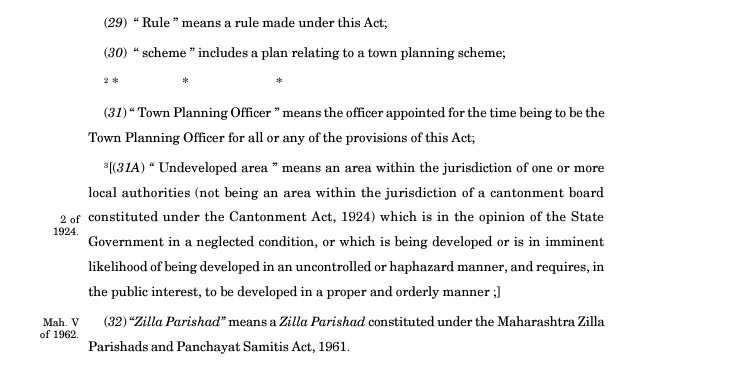
30. “Scheme”
includes a plan relating to a town planning schemes-
The term “Scheme” as used in the Maharashtra Regional and Town Planning Act refers to any plan that is developed and implemented in accordance with the provisions of the Act. This may include a variety of plans such as development plans, town planning schemes, regional plans, or any other plan that is aimed at the orderly and planned development of a particular area.
The scope of the term “Scheme” is quite broad and encompasses a range of planning activities that may be undertaken by a Planning Authority. The Act provides for the creation of various types of schemes depending on the specific needs and requirements of the area in question. These schemes may be developed by the Planning Authority or by other government agencies, and may involve a range of stakeholders including private developers, local communities, and other interested parties.
Section 2(30) of the Maharashtra Regional and Town Planning Act, 1966 defines “scheme” as any plan prepared and executed under the provisions of the Act. The scope of this definition has been elaborated by the courts in various cases. In the case of Ram Pralhad Khatri & Ors. v. State of Maharashtra & Ors., it was observed that the term “scheme” would not only mean the preliminary or final town planning scheme but also a plan showing the area to be included in the scheme as contemplated under Section 60(2) of the Act.
Section 60(2) of the Act empowers the State Government to publish a notification declaring its intention to include any area within the limits of the proposed scheme. This means that any plan or map prepared for the purpose of including an area within the scheme would also fall within the definition of “scheme” under Section 2(30) of the Act.
Therefore, the scope of Section 2(30) is not limited to the preliminary or final town planning scheme but also includes any plan or map prepared for the purpose of including an area within the proposed scheme.
31. “Town Planning Officer”
means the officer appointed for the time being to be the Town Planning Officer for all or any of the provisions of this Act
(31A) “Undeveloped area”
means an area within the jurisdiction of one or more local authorities (not being an area within the jurisdiction of a cantonment board constituted under the Cantonments Act, 1924) which is in the opinion of the State Government in a neglected condition, or which is being developed or is in imminent likelihood of being developed in an uncontrolled or haphazard manner, and requires, in the public interest, to be developed in a proper and orderly manner
(32) “Zilla Parishad”
means a Zilla Parishad constituted under the Maharashtra Zilla Parishads and Panchayat Samitis Act, 1961.